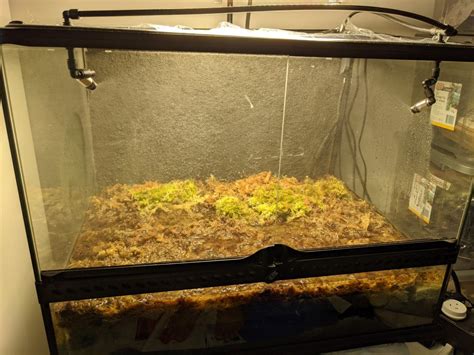How To Keep Humidity In Terrarium
Ronan Farrow
Mar 25, 2025 · 3 min read

Table of Contents
How to Keep Humidity in a Terrarium: A Guide for Beginners and Experts
Maintaining the right humidity level is crucial for the health and well-being of your terrarium inhabitants, whether they're plants, amphibians, or reptiles. A terrarium's humidity depends on several factors, and understanding these is key to creating a thriving ecosystem. This guide will walk you through effective methods to keep humidity levels consistent and optimal within your terrarium.
Understanding Humidity and Your Terrarium
Before diving into methods, let's clarify what humidity is and why it matters. Humidity refers to the amount of water vapor in the air. In a terrarium, appropriate humidity prevents dehydration in plants and animals, supports healthy growth, and even influences the behavior of some species. Too little humidity leads to dryness, while excessive humidity can cause mold and fungal growth.
Factors Affecting Terrarium Humidity:
- Enclosure Size and Material: Smaller terrariums lose humidity faster than larger ones. Glass terrariums retain humidity better than open-topped or plastic containers.
- Ventilation: While essential for air circulation and preventing mold, excessive ventilation can drastically reduce humidity. You need to strike a balance.
- Substrate: The type of substrate (e.g., soil, coco coir, sphagnum moss) plays a significant role. Some substrates retain moisture better than others.
- Plants: Plants themselves contribute to humidity through transpiration (releasing water vapor). More plants generally mean higher humidity.
- Watering: The frequency and method of watering directly impact humidity levels.
Effective Methods to Maintain Terrarium Humidity
Now let's explore proven techniques to keep your terrarium humid:
1. Choosing the Right Substrate:
Select moisture-retentive substrates: Coco coir, sphagnum moss, and peat moss are excellent choices. These materials hold water effectively and gradually release it into the air, maintaining humidity.
2. Misting:
Regular misting: A simple but effective method. Use a spray bottle filled with filtered or distilled water to mist the inside of the terrarium several times a day, focusing on the plants and substrate.
3. Water Features:
Small water features: A shallow dish or a small waterfall adds both visual appeal and humidity. The evaporating water increases moisture in the air. Make sure the water feature is safe for your terrarium inhabitants.
4. Utilizing a Hygrometer:
Monitor humidity levels: A hygrometer is a must-have tool. It accurately measures humidity, enabling you to adjust your methods accordingly. Aim for the ideal humidity range for your specific terrarium inhabitants.
5. Covering the Terrarium:
Partial or full cover: Consider using a glass or plastic lid to help trap moisture within the terrarium. You may need to adjust ventilation to prevent excessive moisture build-up.
6. Proper Ventilation:
Balanced ventilation: Find the sweet spot. Enough ventilation to prevent mold, but not so much that humidity drops too low. This often involves experimenting and observing your terrarium.
7. Choosing the Right Plants:
Humidity-loving plants: Select plants that naturally thrive in humid environments. They'll contribute to moisture levels and create a balanced ecosystem.
Troubleshooting Low Humidity
If your terrarium's humidity is too low, consider the following:
- Increase misting frequency.
- Add more moisture-retentive substrate.
- Reduce ventilation.
- Add a water feature.
- Check for leaks.
Troubleshooting High Humidity
Conversely, if humidity is too high:
- Increase ventilation.
- Reduce misting.
- Use less moisture-retentive substrate.
- Remove excess water.
- Ensure proper drainage.
By carefully considering these factors and techniques, you can create and maintain the perfect humidity level for a thriving and healthy terrarium environment. Remember to observe your terrarium regularly and adjust your approach as needed. Happy terrariums!
Featured Posts
Also read the following articles
| Article Title | Date |
|---|---|
| How To Make Rolling Papers | Mar 25, 2025 |
| How To Remagnetize A Hotel Key Card | Mar 25, 2025 |
| How To Naturally Close Gaps In Teeth | Mar 25, 2025 |
| How To Pattern A Shotgun For Trap | Mar 25, 2025 |
| How To Make Citrus Spray For Carpenter Bees | Mar 25, 2025 |
Latest Posts
Thank you for visiting our website which covers about How To Keep Humidity In Terrarium . We hope the information provided has been useful to you. Feel free to contact us if you have any questions or need further assistance. See you next time and don't miss to bookmark.
